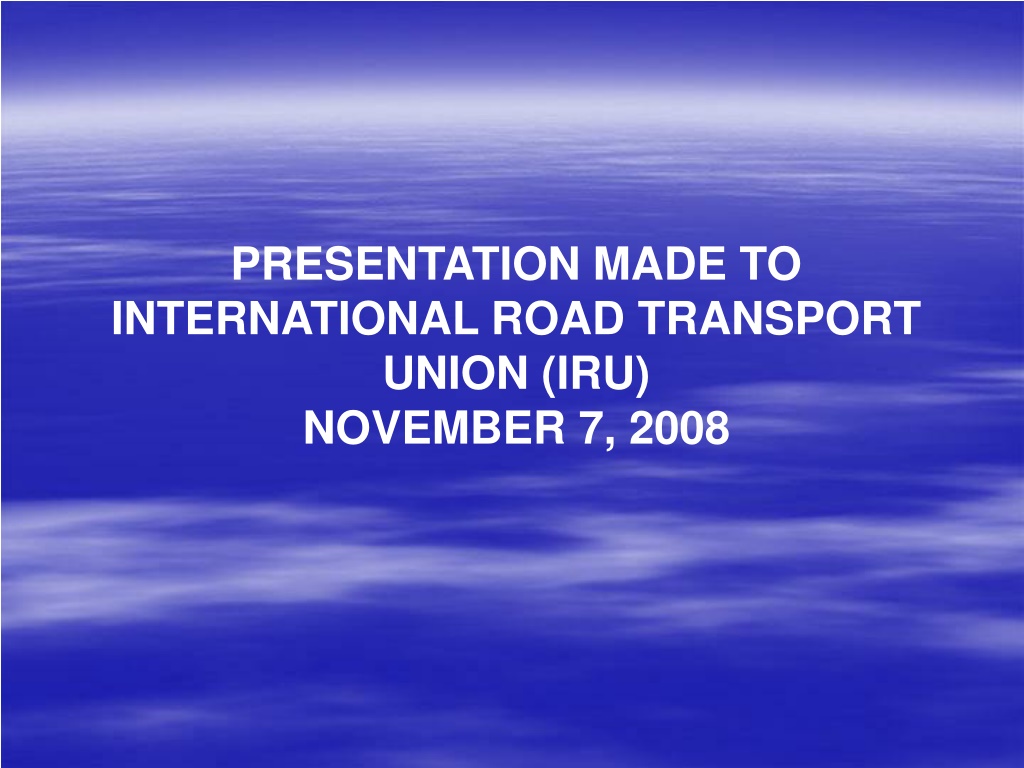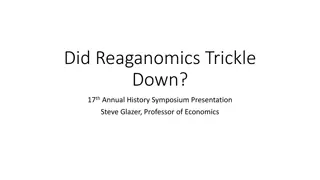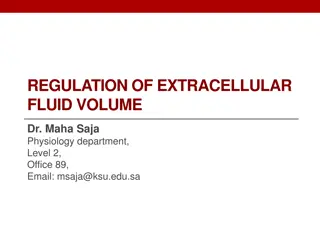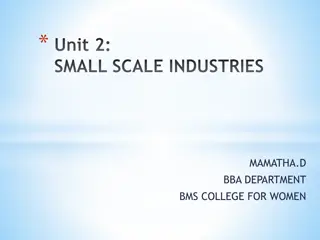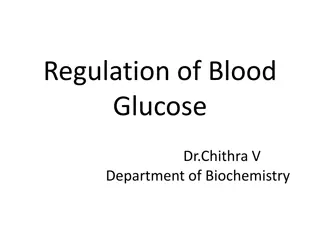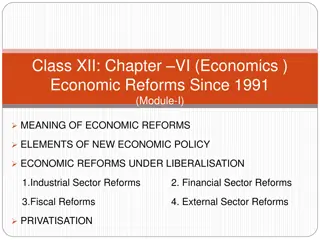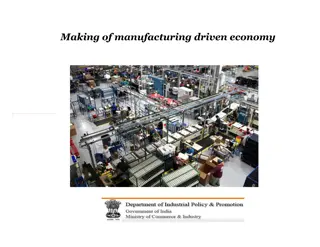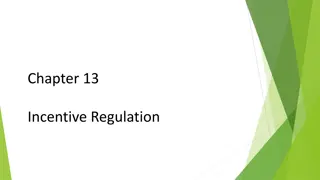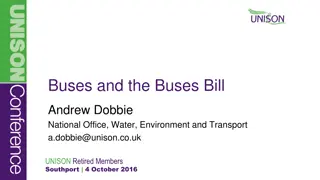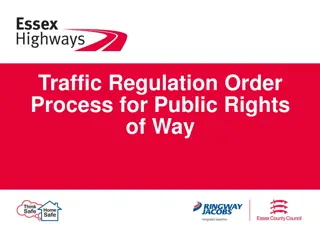Regulation vs. Deregulation in Taxicab & FHV Industries in the US
Addressing the International Road Transport Union in 2008, this presentation covers the role of the Taxicab, Limousine & Paratransit Association (TLPA) in representing the for-hire transportation industry in the U.S. It delves into regulatory efforts, industry standards, and the challenges faced by the taxi industry amidst evolving regulations and changing service standards.
Uploaded on Sep 07, 2024 | 2 Views
Download Presentation

Please find below an Image/Link to download the presentation.
The content on the website is provided AS IS for your information and personal use only. It may not be sold, licensed, or shared on other websites without obtaining consent from the author. Download presentation by click this link. If you encounter any issues during the download, it is possible that the publisher has removed the file from their server.
E N D
Presentation Transcript
PRESENTATION MADE TO INTERNATIONAL ROAD TRANSPORT UNION (IRU) NOVEMBER 7, 2008
It is an honor and pleasure to be here today to address this August body on the issue of Regulation vs. Deregulation in the Taxicab & FHV industries in the United States. I WOULD FIRST LIKE TO GIVE YOU AN INTRODUCTION TO THE TLPA.
Introduction of TLPA Nonprofit trade association formed in 1917 to represent the taxicab industry Currently represents all for-hire providers of local ground transportation services 1,000 member companies that operate 100,000 passenger vehicles TLPA members transport 900 million passengers per year Full industry transports 2 billion passengers per year in the U.S.
Introduction of Victor Dizengoff I became Executive Director and a Board member of The Black Car Assistance Corporation (BCAC) in 1990 For the past 49 years, I have been involved in the taxicab industry in various capacities: Driver, Owner and Executive Director and on the outside looking in as an industry newspaper publisher. I have testified on taxicab industry and FHV issues before State, County and Municipal governments and their respective regulatory agencies.
Review of Current Taxi Regulatory Efforts Conducted by TLPA Taxicab driver standards were developed for major cities by TLPA in 2006. I have a copy of those standards available for your review with me today. (Attachment A) Taxicab company standards were developed by TLPA last year. I have a copy of those company standards available here for your review. (Attachment B) TLPA is the only organization in the U.S. that continuously studies and monitors the taxicab industry and its regulations at the national level TLPA has just issued a contract to begin the development of a web-based driver training program that has the potential to benefit every taxicab passenger, company and driver in the U.S.
Current State of Taxi Regulation Since its inception, the taxicab industry has always faced regulatory questions such as what safety requirements are needed, what is the proper fare, how many taxicabs are needed, how many taxicab companies are needed, who are the regulations designed for (the public, fleet owners, drivers), should there be quality of service standards, and the list goes on. The newest question is what happened to full service taxicab companies that used to give us really good service?
Current State of Taxi Regulation (continued) The answers to those questions for major metropolitan areas in the U.S. are: For safety, you have vehicle inspections and commercial auto liability insurance requirements. Fares are regulated and typically there is one uniform fare for all taxicabs in the city or county. The number of taxicabs is limited, but subject to periodic review to determine if more or fewer taxicabs are needed to meet public demand for service.
Current State of Taxi Regulation (continued) Regarding the number of companies, there is less uniformity, but generally existing companies are kept in place. If tremendous dissatisfaction arises with the service provided by the current companies, then one new company that can meet what are typically new and more stringent standards for all companies (aimed at correcting whatever deficiency is deemed to exist in the industry) is allowed to start up as long as it meets the community s minimum fleet size requirement.
Current State of Taxi Regulation (continued) The taxicab regulations should be designed to provide a safe, comfortable, reasonably priced ride and timely service to the public where both the taxicab company and the taxicab driver are able to make a reasonable profit. In this model, the general public is the primary beneficiary of the regulations, followed by the company that is funding and managing the infrastructure that is providing the public service, and then the driver who is providing the on the street labor, which is the final necessary service component.
Current State of Taxi Regulation (continued) Quality of service regulations is the newest discussion point. TLPA has recently established a national consensus by recommending its set of quality of service standards for major metropolitan areas. Researchers and community leaders are beginning to understand the absolute need for the reestablishment of full service taxicab companies. To have a quality taxicab service, the community must have full service taxicab companies that invest in building the taxicab infrastructure. That infrastructure (newer vehicles, preventive maintenance for vehicles, computer dispatch with vehicle location capability, call center personnel, insurance claims management personnel, accounting and non,cash payment processing capability and staff, management staff, etc.) is necessary before community wide service that is safe, comfortable, reasonably priced and timely can be delivered. Attached is a paper by Dr. Ray Mundy, Director of the Center for Transportation Studies, University of Missouri St. Louis, on regulatory structures that foster improved taxicab service. (Attachment C)
The Promise of Deregulation Lower fares Higher quality of service Diversification of services offered Expanded service areas, particularly for low income neighborhoods Opportunity to succeed or fail based on the individual s abilities Administration of the industry will be easier and less costly
The Reality of Taxicab Deregulation Fares jump dramatically, an average of 29% in the first year, between 60% and 70% over the first three years, and over time the fares remain higher than other comparable city taxicab rates Service quality deteriorates older vehicles, short trip refusals, decline in neighborhood service, overcrowding at airport and other major trip generators such as downtown hotels There is virtually no diversification of services offered There is virtually no expansion of the service area There is no opportunity to succeed when a plan is implemented that is proven beyond a reasonable doubt to harm the service to the passengers, reduce investment in service infrastructure by the companies, and force drivers to work longer hours for less money Administrative time and costs increase significantly to deal with the influx of new drivers and consumer complaints
Review of USDOT Studies on Specific Cities that Deregulated in the late 70s early 80s In case this body considers a deregulatory policy that has been proven to fail in the taxicab industry, I would like to present to you a few very brief direct quotes from studies sponsored by the USDOT. These studies were conducted by the Reagan Administration in the early 1980s when they promoted taxicab deregulation for several years until the policy failed. At that time, TLPA charged that these reports were biased, as we felt the researchers left out key industry information to make the outcome look better than it was. But, in retrospect, the USDOT reports confirm the absolute failure of deregulation in the taxicab industry to achieve any of the outcomes that deregulatory advocates promise.
Review of USDOT Studies on Specific Cities that Deregulated in the late 70s early 80s (continued) These reports are a bit dated, but they are the U.S. Government documented outcome of several key cities that experimented with taxicab deregulation. Indianapolis, Indiana Seattle, Washington San Diego, California Phoenix, Arizona This report was published by the USDOT in April of 1984.
Review of USDOT Studies on Specific Cities that Deregulated in the late 70s early 80s (continued) Since the deregulation failures of the late 1970s and early 1980s, only two relatively large cities have experimented with taxicab deregulation. In 1994, both Cincinnati and Indianapolis deregulated their taxicab industries. I guess they thought that because a decade had passed since the last taxicab deregulation failure, that they would try again. Even though times had changed, the fundamentals of the taxicab industry had not and the results were no different. Taxicab drivers have become labeled taxicab companies, but regardless of what you call them, they struggle to survive and the cities incrementally keep adding regulatory requirements to bring the industry back to where it started, which is fully regulated. I can honestly say that nationally the major debate over taxicab deregulation is over. Yes the issue arises and some cities may still implement it from time to time, but we know what the outcome will be and we know that over the long term, the cities will reregulate.
Recommended Future Course for Taxi Regulations More important than discussing the failure of taxicab deregulation is a discussion of what constitutes the most effective current taxicab regulation. Items that need to be addressed for the full community to have taxicab service that meets the travel needs of the public in a safe, comfortable, timely and cost effective way would include:
Recommended Future Course for Taxi Regulations (continued) Safety: insurance requirements, regulatory enforcement, vehicle inspections and age limits, required automated dispatch system Taxicab Fares: uniform fare, taximeter, fare review Quantity of Taxicabs and Taxicab Companies: limits on the number of taxicabs, limits on the number of taxicab companies Quality of Service: fleet branding, driver standards, company service standards, quality assurance, minimum fleet size
Conclusion There are a variety of factors, such as costs, technological advances, and changes in service demands that require taxicab regulations be periodically fine-tuned. Regulatory adjustments to taxicab fares are routine, but when one examines changes to the number of taxicabs, safety requirements, driver standards and/or company standards everyone becomes more concerned that there will be winners and losers. I would urge that instead of trying to predetermine who the winners and losers will be, promote regulations that enhance the quality of service that current and future taxicab passengers will receive. Quality service requires investment. As long as the existing companies are willing and able to make that investment and the passengers pay a reasonable fare and the drivers make a reasonable living, then the community is the winner and only those taxicab operators and drivers who are not willing to do their fair share will be the losers.
I will be happy to answer any questions that you may have regarding my presentation or on the subject of proper taxicab regulations. Also, you may contact me in the future at the TLPA office: Taxicab, Limousine & Paratransit Association, 3200 Tower Oaks Boulevard, Suite 220, Rockville, Maryland 20852; telephone (301) 984-5700; fax (301) 984-5703; or at my direct contact information, which is as follows: (212) 269-4800 ext. 255; fax (212) 269-8200; e-mail vdizengoff@newyorkblackcarfund.org.
